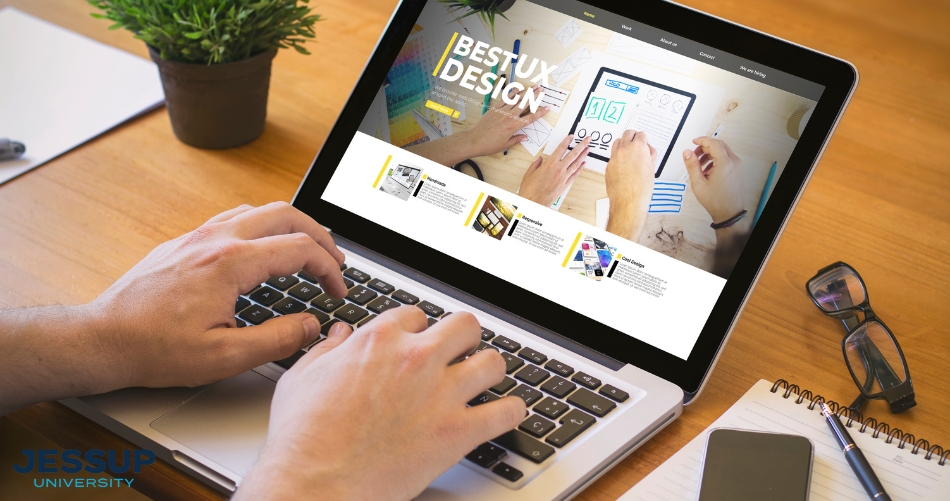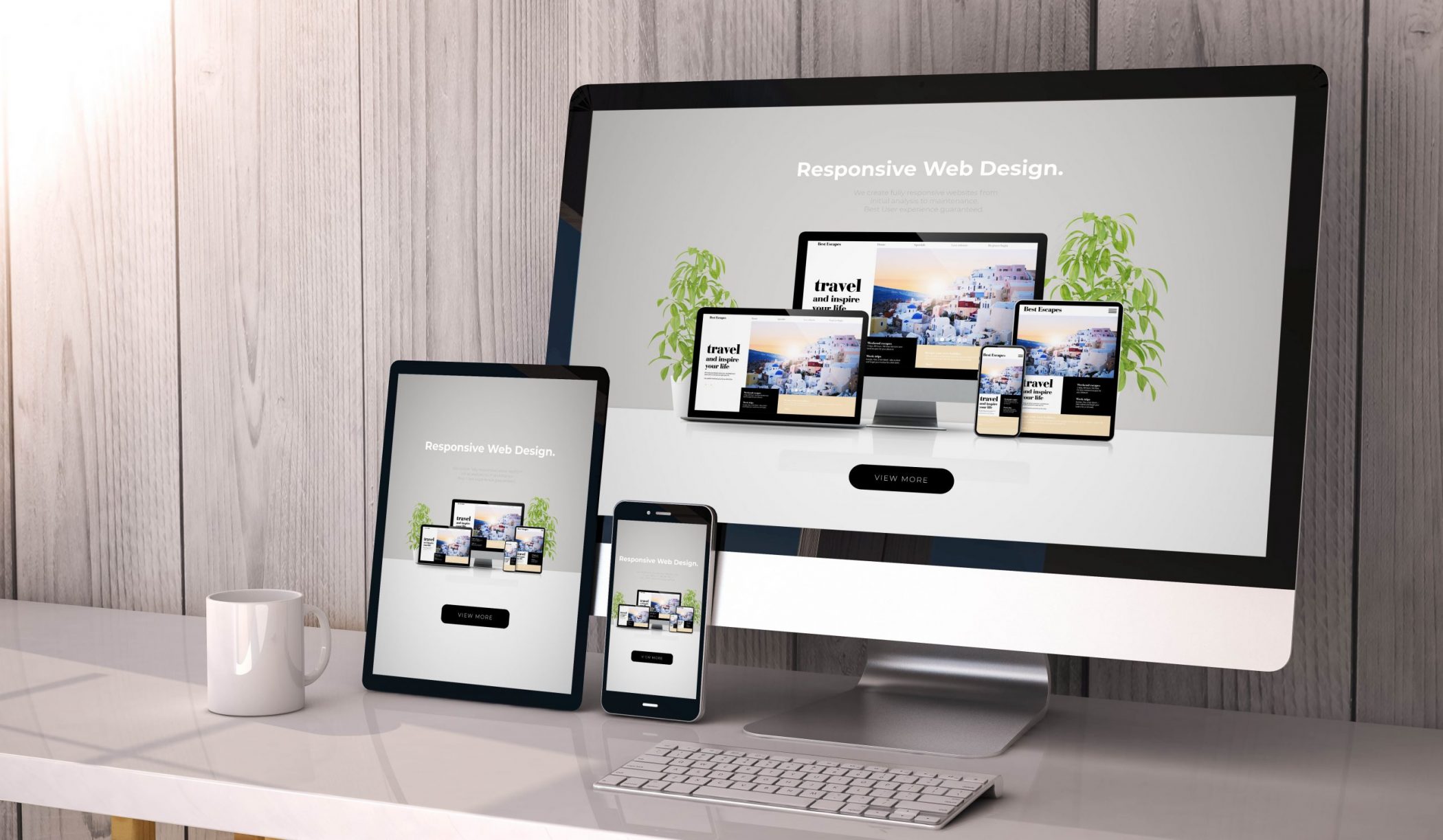Discovering Imaginative Trends in Web Design for Modern Businesses
The landscape of web design is constantly developing, reflecting the vibrant requirements of modern businesses. Current fads highlight a choice for minimalism, vibrant typography, and engaging interactivity. Business significantly focus on user experience with mobile-first concepts and personalized web content. In addition, a concentrate on sustainability is getting traction. Comprehending these patterns is necessary for organizations aiming to stand apart in a congested marketplace. What effects do these shifts hold for the future of electronic involvement?
Accepting Strong Typography
Bold typography has become a defining element in modern web design, catching focus and sharing messages with striking clearness. This trend focuses on visually impactful message that enhances user involvement and brand name identification. Developers usually make use of large fonts and one-of-a-kind fonts to produce a power structure, directing audiences via web content effortlessly.
The strategic use strong typography enables for effective storytelling, allowing brands to connect their values succinctly. It offers not only aesthetic functions however also practical ones, as it boosts readability across gadgets and display sizes.
As internet sites compete for user interest, strong typography attracts attention in a saturated electronic landscape. Its flexibility allows developers to experiment with contrasting formats and colors, additionally enhancing its performance. Eventually, accepting strong typography stands for a change in the direction of more meaningful and communicative web design, promoting a deeper connection in between brands and their target markets.
The Increase of Minimalist Style
As electronic settings come to be progressively messy, the increase of minimalist style provides a renewing option that focuses on simplicity and functionality. This style philosophy remove unneeded components, enabling content to take spotlight. By concentrating on tidy lines, enough white room, and a minimal color combination, minimal design enhances user experience and enhances navigation.
Companies adopting this fad objective to share their brand name message clearly and properly, cultivating a sense of tranquility and quality. The lack of diversions assists users concentrate on important details, causing improved engagement and conversion prices. Additionally, minimalist design straightens well with mobile-first strategies, making certain that web sites stay accessible and user-friendly across various gadgets.
Eventually, the increase of minimalist design reflects a broader change towards focusing on user requirements and choices, making it a powerful tool for modern services looking to make a long-term effect in the electronic landscape.
Immersive Animations and Interactivity
While lots of web developers welcome minimal aesthetic appeals, another compelling pattern gaining grip is using immersive computer animations and interactivity. This technique enhances user engagement by developing fascinating experiences that attract visitors right into the content. Designers utilize dynamic components such as computer animated backgrounds, scrolling effects, and interactive infographics to connect intricate ideas in an obtainable way.
These animations not only provide visual rate of interest however likewise overview users through the navigation process, making interactions a lot more instinctive. Float results and computer animated changes can encourage individuals to discover further, leading to increased time spent on the website.
Moreover, this pattern straightens with the wider activity in the direction of storytelling in web design, where computer animations offer as narrative tools that share brand messages successfully. By integrating immersive animations and interactivity, organizations can separate themselves in a congested online landscape, ultimately boosting user complete satisfaction and brand name commitment.
Mobile-First Style Principles
Mobile-first layout principles highlight focusing on user experience by making certain internet sites work perfectly on smaller sized displays. This method includes receptive format methods that adjust to different device sizes while keeping aesthetic stability. Additionally, it concentrates on touchscreen navigating layout, enhancing usability for mobile individuals.
Focusing On User Experience
Exactly how can developers efficiently focus on user experience in an increasingly mobile-centric world? Emphasizing mobile-first layout concepts is crucial, as individuals primarily engage with internet sites with mobile gadgets. This technique encourages designers to enhance content, guaranteeing it is easily available and accessible on smaller sized displays. Key techniques include simplifying navigating, lessening tons times, and utilizing touch-friendly elements that enhance interactivity. Furthermore, focusing on readable typography and user-friendly formats can significantly enhance user contentment. Designers should continually collect user responses to refine their methods, adjusting to progressing user needs and choices. By concentrating on these aspects, companies can create an interesting digital experience that cultivates commitment and drives conversions, ultimately lining up with the expectations of today's mobile users.
Responsive Layout Methods
Designers embrace receptive design strategies to develop adaptive and flexible internet experiences that accommodate numerous display sizes. This method prioritizes mobile-first style principles, ensuring peak functionality on smaller sized gadgets before scaling up for bigger displays. By making use of fluid grids, versatile images, and media questions, developers can keep a cohesive visual identification across all systems. This strategy not only improves user involvement yet also improves search engine positions, as mobile-friendly sites are preferred by search formulas. In addition, responsive formats enable businesses to get to a more comprehensive target market, visit this site right here suiting individuals on smart devices, desktop computers, and tablets alike. Generally, carrying out these techniques is essential for modern web design, ensuring that services visit site remain affordable in an ever-evolving digital landscape.
Touchscreen Navigating Design
With the surge of mobile phones, touchscreen navigation has actually become an essential facet of web design. Developers are progressively adopting mobile-first principles to improve user experience and engagement. Web Design services. Effective touchscreen navigating prioritizes larger switches and intuitive gestures, permitting customers to interact conveniently with web content. This technique decreases irritation and motivates expedition, as customers can navigate flawlessly with their fingers. Additionally, incorporating swipe gestures and tap functionality deals with the all-natural habits of mobile users. Responses mechanisms, such as visual cues and animations, enhance functionality additionally by validating actions. As touchscreens control user communications, using these layout components not just straightens with contemporary assumptions however also fosters a more easily accessible and delightful searching experience for all individuals
Customized User Experiences
What makes an individual really feel genuinely involved on a web site? The response usually hinges on individualized user experiences. By tailoring material and navigating to individual choices, services can produce a significant connection with their audience. This customization can be achieved with numerous approaches, such as evaluating user habits, utilizing cookies, and offering tailored recommendations based on previous communications.
For example, ecommerce platforms that suggest items based upon browsing history not only improve user experience however additionally enhance conversion rates. In addition, integrating vibrant web content that adjusts to the user's area or time of day can additionally improve involvement.
Additionally, customized greetings or messages can make individuals feel valued and comprehended. As contemporary companies endeavor to stand apart in a competitive electronic landscape, embracing customized user experiences becomes essential, fostering commitment and encouraging repeat gos to. Ultimately, this strategy transforms a common site into an interactive system that reverberates with its target market.
Sustainability in Web Design
As the digital landscape remains to evolve, the significance of sustainability in web design has actually obtained significant interest. Developers are increasingly familiar with the ecological influence their creations can have, motivating a shift towards green practices (Web Design services). Lasting web design concentrates on enhancing websites to decrease power consumption and carbon footprints. Techniques include using minimalistic layout principles, maximizing images, and utilizing efficient coding techniques to improve loading rates
The choice of holding carriers plays a vital role; many developers are currently opting for environment-friendly organizing services powered by sustainable energy. By prioritizing ease of access and user-friendly navigating, lasting styles additionally accommodate a more comprehensive audience, enhancing use. This conscious strategy not just attract environmentally-minded consumers however likewise adds to the general longevity and performance of internet sites. Eventually, sustainability in web design shows a growing fad towards liable digital methods that straighten with modern organization values.

Often Asked Inquiries
Exactly How Can I Pick the Right Color System for My Website?
To select the appropriate color design for a site, one need to take into consideration the brand's identity, target market, and emotional effect. Using shade concept and screening combinations can improve user experience and visual charm significantly.
What Are the most effective Devices for Prototyping Internet Styles?
The most effective devices for prototyping website design consist of Figma, Sketch, Adobe XD, and InVision. These systems use intuitive interfaces, collaboration features, and comprehensive collections, making them optimal for developers to create and refine their concepts efficiently.
Exactly how Do I Gauge the Efficiency of My Web Design?
To determine web design efficiency, one ought to evaluate user involvement metrics, conversion prices, and use comments (agency for web design). A/B screening and heatmaps can likewise offer understandings into user behavior, directing essential modifications for enhanced efficiency and user experience
What Are Common Web Design Mistakes to Stay Clear Of?
Usual web design mistakes consist of cluttered layouts, bad navigation, sluggish filling times, absence of mobile optimization, inadequate contrast, and disregarding user comments. Avoiding these risks boosts user experience click to read and raises general effectiveness of the website.
How Frequently Should I Update My Website Layout?
A web site design need to be upgraded every 2 to three years, or earlier if substantial modifications in branding or modern technology happen. Regular updates maintain the site fresh, practical, and lined up with existing user expectations.
